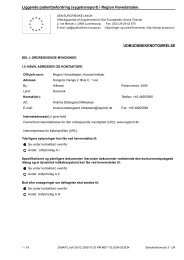Territorial Review Copenhagen - Region Hovedstaden
Territorial Review Copenhagen - Region Hovedstaden
Territorial Review Copenhagen - Region Hovedstaden
You also want an ePaper? Increase the reach of your titles
YUMPU automatically turns print PDFs into web optimized ePapers that Google loves.
165<br />
operation of the bridge will generate a net gain of about EUR 1.9 billion over a<br />
period of 50 years. The most substantial impacts will occur in the direct vicinity<br />
of the bridge; regions that will experience the greatest impact will be Lübeck<br />
and Kiel on the German side (four times the regional GDP) and Lolland-Falster<br />
on the Danish side (more than four times the regional GDP). Sjaelland will also<br />
benefit from the new infrastructure, while Fünen and Jutland will be unaffected.<br />
According to this study, positive effects will be felt as far as Örebro in Sweden<br />
(700 kilometres to the north) and Hesse in Germany (600 kilometres to the<br />
south). These considerations take into account the argument that employment in<br />
the ferry service industries will decline. There will also be a loss of maritimerelated<br />
jobs.<br />
According to a second study by <strong>Copenhagen</strong> Economics and Prognos 3 in<br />
2006, the following sectors will benefit most from the new infrastructure:<br />
construction (direct effect), tourism (increased potential and competitiveness),<br />
export-oriented SMEs (transport costs will decrease and there will be positive<br />
stimuli to cluster health care and medical technology). To realise these benefits,<br />
a common strategy should be developed. For Storstrøms in Denmark, the<br />
transport and logistics industries appear to have limited possibilities for<br />
developing into a large cluster, but business and employment in other sectors<br />
will increase, such as metals, paper and agriculture. Positive effects are expected<br />
through the improved use of German clusters and knowledge institutions that<br />
deal with seeds, vegetable fibres and composites, as well as the fields of<br />
environment, energy and waste. Benefits are also expected from increased<br />
tourism activities, especially if a common strategy can be developed with<br />
Ostholstein. According to the study, tourism could increase by 20% as a result of<br />
the fixed link. Day-to-day commuting across the Øresund, however, is not<br />
expected on a large scale. With regard to Ostholstein, broad development in the<br />
health care sector is expected, as well as some growth in tourism. Moreover, a<br />
fixed Fehmarn Belt link will offer new prospects for the port of Puttgarden.<br />
Situated at the intersection of the Kiel-Baltic seaway, it may be able to develop<br />
into a more competitive maritime business location.<br />
Notes:<br />
1. BMVBS/Germany and Trafikministeriet Denmark: Kocks Consult GmbH, Institute of<br />
Shipping Economics and Logistics Bremen and Carl Bro A/S Consulting Engineers<br />
Glostrup: Investigation of Socio-Economic and <strong>Region</strong>al Consequences of a Fixed Link<br />
Across the Fehmarnbelt, 1999.<br />
2. <strong>Copenhagen</strong> Economics and Prognos, Economy-wide Benefits: Dynamic and Strategic<br />
Effects of a Fehmarnbelt Fixed Link, 2004, at<br />
www.bmvbs.de/Anlage/original_950362/Economy-wide-benefits_-Dynamic-and-<br />
Strategic-Effects-of-a-Fehmarn-Belt-Fixed-Link_-June-2004.pdf.<br />
3. <strong>Copenhagen</strong> Economics and Prognos, <strong>Region</strong>al Effects of a Fixed Fehmarn Belt Link,<br />
2006, under: www.bmvbs.de/Anlage/original_950359/<strong>Region</strong>al-Effects-of-a-Fixed-<br />
Fehmarn-Belt-Link_-February-2006.pdf.

















